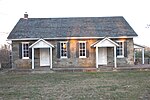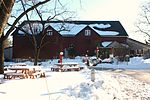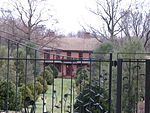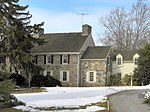The Plant Collections Network (PCN) (formerly the North American Plant Collections Consortium) is a group of North American botanical gardens and arboreta that coordinates a continent-wide approach to plant germplasm preservation, and promotes excellence in plant collections management. The program is administered by the American Public Gardens Association from its headquarters in Kennett Square, Pennsylvania, in collaboration with the USDA Agricultural Research Service.
Current objectives of the Plant Collections Network are to:
Build Awareness – of both Plant Collections Network & value of documented plant collections
Promote Standards of Excellence – in plant collections management; and
Expand Diversity of Collections – target existing collections, identify gaps for future collectionsThe network is intended to represent woody and herbaceous ornamentals, both native and exotic. The main objective for each network member is to assemble a comprehensive group of plants for a particular taxon, collecting plants from different populations throughout their natural range that are both taxonomically and genetically distinct.
Participating institutions maximize the potential value of their collections by making efficient use of available resources through a coordinated continent-wide approach, and strengthening their own collections through collaboration with others.
Criteria for participation in the Plant Collections Network are:
American Public Gardens Association membership
Active collections management program including plant records database, accession labels, maps
Long-term commitment to maintain collection
Endorsement of governing body
Current collection has 50% or more of ultimate collection scope
Collections policy
Curator for collection; and
Access to collection for research, evaluation and plant introductionThe accreditation process includes submitting a written application for each collection to be considered, then a peer site reviewer conducts an onsite assessment and submits a report with recommendations.As of March 2016, Network participants and Nationally Accredited Plant Collections included:
Arizona-Sonora Desert Museum
Agavaceae – Sonoran Desert; 65 taxa
Arboretum at Arizona State University
Phoenix; 300 taxa, 40 varieties
Arnold Arboretum of Harvard University
Acer; multi-site
Carya; 16 taxa, 11 spp
Fagus; 26 taxa
Stewartia; 11 taxa
Syringa; 238 taxa, 20 spp
Tsuga; 72 taxa, 7 spp
Atlanta Botanical Garden
Acer; 82 taxa
Magnolia; multi-site
Sarracenia; 78 taxa
Bartlett Tree Research Laboratory and Arboretum
Acer; multi-site
Hamamelis; 161 taxa
Magnolia; multi-site
Quercus; multi-site
Ulmus; 62 taxa
Betty Ford Alpine Gardens
Alpine Plants of Colorado; 87 taxa
Boyce Thompson Arboretum
Fabaceae – Desert Legumes; 1454 taxa as seeds, 206 taxa as plants
Quercus; multi-site
University of British Columbia Botanical Garden
Acer; multi-site
Magnolia; multi-site
University of California Botanical Garden at Berkeley
Cycads; multi-site
Ferns; 360 taxa, with 500+ accessions
Magnolia; multi-site
Quercus; multi-site
Cheekwood Botanical Garden
Cornus; 61 taxa
Chicago Botanic Garden
Geranium; 102 taxa
Quercus; 48 taxa
Spiraea; 52 taxa
Cornell Plantations
Acer; multi-site
Quercus; multi-site
Donald E. Davis Arboretum
Quercus; multi-site
University of California Davis Arboretum
Quercus; multi-site
Dawes Arboretum
Acer; multi-site
Aesculus; 59 taxa
Hamamelis; 75 taxa
Metasequoia; 9 taxa, with 47 accessions of documented wild-origin, 8 cultivars
Denver Botanic Gardens
Alpine Plants of the World; 223 taxa
Quercus; multi-site
Desert Botanical Garden
Agavaceae; 346 taxa
Cactaceae; 1319 taxa
The Arboretum at Flagstaff
Penstemon (provisional) – Colorado Plateau, Arizona species; 37 taxa
University of Florida – North Florida Research and Education Center
Magnolia; multi-site
Fort Worth Botanic Garden
Begonia; 1001 taxa
Fullerton Arboretum (California State University)
Citrus; 36 accessions, representing 20 taxa
Ganna Walska Lotusland
Cycads; multi-site
Green Spring Gardens Park
Hamamelis; 80 taxa, including all 4 spp
Henry Foundation for Botanical Research
Magnolia; multi-site
Highstead Arboretum
Kalmia; 82 taxa, including 3 spp, 76 cultivars, 4 forms, 2 hybrids
Holden Arboretum
Quercus; multi-site
Hoyt Arboretum
Acer; multi-site
Magnolia; multi-site
The Huntington Botanical Gardens
Camellia; 1240 taxa, including 40 spp, 1200 cultivars
Huntsville Botanical Garden
Trillium; 66 taxa, including 28 spp
Idaho Botanical Garden
Penstemon – Western US (provisional); 33 taxa
Jenkins Arboretum
Kalmia; 48 taxa
Rhododendron; 1861 taxa
Jensen-Olson Arboretum
Primula; 65 taxa
George Landis Arboretum
Quercus of the Northeast U.S.; 14 taxa, 9 spp
Springs Preserve
Mojave Desert Cacti and Succulents; 28 taxa
Longwood Gardens
Nymphaea; 97 taxa
Matthaei Botanical Gardens and Nichols Arboretum
Paeonia; 317 taxa, with 467 plants
Mendocino Coast Botanical Gardens
Heath and Heather; 134 taxa
Minnesota Landscape Arboretum
Grasses; 184 taxa
Pinus; 60 taxa
Missouri Botanical Garden
Quercus; multi-site
Montgomery Botanical Center
Arecaceae; 356 taxa
Cycads; multi-site
Montreal Botanical Garden
Rosa; 1097 taxa, including 115 spp
Moore Farms Botanical Garden
Magnolia; multi-site
Morris Arboretum of the University of Pennsylvania
Abies; 35 taxa, including cultivars
Acer; multi-site
Quercus; multi-site
Morton Arboretum
Acer; multi-site
Magnolia; multi-site
Malus; 185 taxa, 9 out of 10 known species, plus cultivars
Quercus; multi-site
Tilia; 45 taxa
Ulmus; 78 taxa, 35 spp, 43 hybrids and cultivars
Mount Auburn Cemetery
Quercus; multi-site
Mt. Cuba Center
Hexastylis; 39 taxa, including 10 spp
Trillium; 84 taxa
Naples Botanical Garden
Plumeria; 585 taxa
New England Wild Flower Society
Trillium; 28 taxa
New York Botanical Garden
Acer; multi-site
Quercus; multi-site
Norfolk Botanical Garden
Camellia; 525 taxa
Hydrangea; 190 taxa
Lagerstroemia; 75 taxa
North Carolina Arboretum
Rhododendron; 15 spp, native azaleas
Phipps Conservatory and Botanical Gardens
subfamily Cypripedioideae; 352 taxa
Polly Hill Arboretum
Stewartia; 19 taxa
Powell Gardens
Magnolia; multi-site
Quarryhill Botanical Garden
Acer; multi-site
Magnolia (provisional)
Rancho Santa Ana Botanic Garden
Quercus; multi-site
JC Raulston Arboretum
Cercis; 40 taxa, including 7 spp, 33 cultivars
Magnolia; multi-site
Reiman Gardens at Iowa State University
Griffith Buck Roses; 75 cultivars
Rhododendron Species Foundation and Botanical Garden
Rhododendron subsect. Fortunea; 15 taxa, with 104 accessions
Rogerson Clematis Garden
Clematis ; 709 taxa
San Diego Botanic Garden
Bamboo; 121 taxa
San Diego Zoo Global
Cycads; multi-site
Orchids; 907 taxa
San Francisco Botanical Garden at Strybing Arboretum
Arecaceae – high elevation; 107 taxa
Magnolia; multi-site
Mesoamerican Cloud Forest; 550 taxa, primarily from tropical mountains of southern Mexico and Central America
Santa Barbara Botanic Garden
Dudleya; 52 taxa
Scott Arboretum of Swarthmore College
Ilex; 312 taxa
Magnolia; multi-site
Quercus; multi-site
Smithsonian Gardens
Orchids – tropical species; 2400 accessions
South Carolina Botanical Garden
Magnolia; multi-site
Starhill Forest Arboretum
Quercus; multi-site
Taltree Arboretum and Gardens
Quercus; multi-site
Toledo Botanical Garden
Hosta; 495 taxa, including 43 spp, 452 cultivars, with 2500 accessions
Tyler Arboretum
Rhododendron; 529 taxa, with 1493 accessions
United States National Arboretum
Buxus; 190 taxa
University of Washington Botanic Gardens
Acer; multi-site
Ilex; 47 taxa
Magnolia; multi-site
Quercus; multi-site
VanDusen Botanical Garden
Magnolia (provisional)










